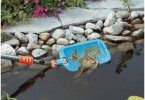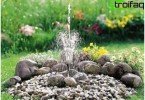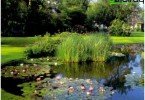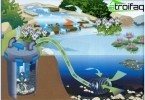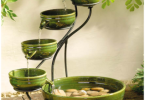From the moment when the personal plot ceases to be only a platform for growing the necessary food, it becomes a field for creativity. Only the limited area of the site itself can stop the fantasy of a skilled summer resident. You can hardly surprise anyone with lawns and a luxurious flowerbed, as well as with an ultramodern barbecue zone or garden sculptures, but fish farming in artificial reservoirs is a rare hobby.
Content
- Choose the appropriate type of pond in the garden
- Features of arrangement of a reservoir with fish
- Stages of creating an artificial reservoir for fish farming
- Caring for an artificial pond with fish
Choose the appropriate type of pond in the garden
It would seem that a pond can be dug in any area, but if the goal is to populate fish in it, then the requirements for construction grow many times over. Water should independently fill its intended deepening, not evaporate completely in the most intense heat and remain moderately clean all season. The limited space makes itself felt: country ponds are rarely large. Fortunately, for breeding most of the popular breeds, large volumes are not required, and many species of fish are unpretentious and gain weight very well even in modest conditions..
It is wonderful if there is already a brook or a small rivulet in the territory of the site, this will solve the problem of water inflow and discharge. It is enough to deepen the channel and build a dam, such a pond is called natural. Suitable not only full-flowing sources, but also dried out. They should be located in the lowlands. The organization of a small isolated pond, dug out specifically, is more time-consuming. You will have to take care not only of the influx of water, but also of the possibility of its descent in the fall. The source of water can be an artesian well running through an accessible remoteness of a stream or highly located strata of groundwater. Ponds, the source of water for which are only rainfall, as a rule, do not survive sunny days and are not suitable for serious breeding of fish.
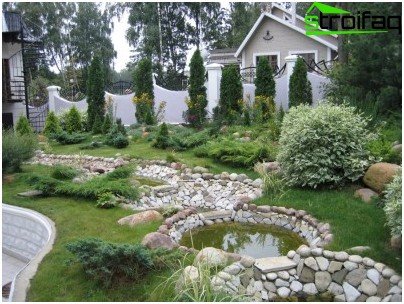
An existing brook in the area is the best source of water for an artificial dam.
The main types of artificial reservoirs for the cultivation of food fish by the type of organization of the pit:
- channel;
- dug;
- boned.
Features of arrangement of a reservoir with fish
Technical specifications and the map of the reservoir depend on plans for its operation. First of all, it is necessary to determine what subspecies of living creatures will be populated in it. If the inhabitants of the pond will become decorative goldfish, then the main attention during the construction is given to the opportunity to watch their games in transparent water. To do this, a multi-level bottom is created, lined with pebbles or other decorative pebbles, with wide shallows where the water will be warmed up by sunlight.

Goldfish live well not only in the aquarium, but also in the open pond with warm and clear water.
If the purpose of equipping the pond is fishing, then its design should take into account the needs of a particular type of fish.
The most popular inhabitants of artificial reservoirs:
- carp and crucian carp, which do not require a large space for life;
- tench surviving even in neglected water bodies with water oxygen less than 1 ml / l;
- crucians that easily survive wintering even in small water bodies freezing almost to the bottom;
- the orff, which is a domesticated variety of the golden ide, unpretentious to food and quickly gaining weight, a fish that gets along well with most of the other inhabitants;
- sturgeon, interest in the cultivation of which is due to the high value of the product;
- pike perch and buffalo, easily giving offspring in relatively small bodies of water;
- pikes that provide themselves with food on their own if small weedy fish live in the same pond;
- channel catfish and river eels, unpretentious to water quality and giving a good increase in body weight.
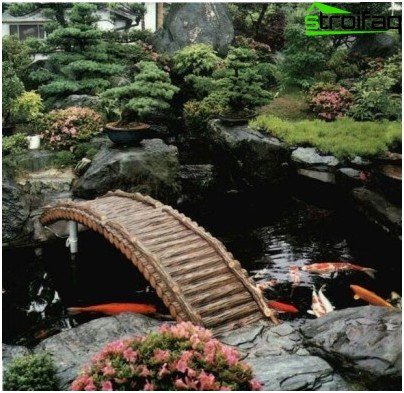
Breeding expensive commercial fish is not only interesting, but also profitable
Choosing a specific type of fish for breeding is a crucial step. It is necessary to take into account both habits and features of the life cycle. Heat-loving carps, crucians, and catfish released into a reservoir constructed from an artesian well may die on the very first day, while salmon and trout cannot exist in an overgrown reservoir with increased siltation of the bottom. If several subspecies are planned to be settled in one reservoir, then their habits will also have to be studied. Predatory pike perch is able to quickly destroy all small fish, including fry, and catfish, launched into a reservoir with a muddy bottom, will regularly dig it up in search of food, poisoning individuals accustomed to clean water. The arrangement of the bottom for goldfish, crayfish and eels is significantly different. The first need pebbles and a rapidly warming water column, the second – broken shards, pipes and other natural shelters, the third – an abundance of green food.
A common feature of most artificial reservoirs intended for fish growing is the presence in the center of a small area with greater depth. Such a zone is created both to simplify the cleaning of the reservoir, and to catch fish before the onset of cold weather..
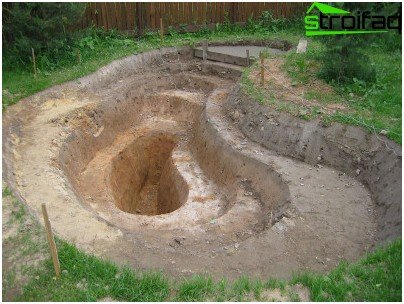
Deepening in the center of the artificial pond makes it easy to clean and complete fishing
The pond, in which, according to the owner’s intention, the fish should not only gain weight, but also produce offspring, should have a well-heated sun and a safe backwater for spawning. However, such difficulties are relevant only for large reservoirs. For a pond with a volume of 5-30 m2, in which the fish is only one season, fry can be launched purchased or caught in natural conditions.

The bottom of a miniature pond does not require concreting, just laying a dense film
Stages of creating an artificial reservoir for fish farming
- Choosing a place and studying the characteristics of the chemical composition of soil and water.
- Digging pit.
- Reinforcing the bottom and shores with thick film, concrete or pressed clay.
- Organization of gutters and landscape features depending on the planned method of pond operation.
- Landing of coastal plants providing shaded backwaters necessary for most fish subspecies.
- Drying the pond (2-3 weeks).
- Starting water into a reservoir and its “settling” by microorganisms. For this purpose, water drawn from a natural reservoir with impurities of silt is added to the composition and algae are planted.
- Leveling the temperature in the cage with the fish prepared for launch and the temperature of the water in the pond to avoid death due to stress.
- Running fish in an artificial pond.
Caring for an artificial pond with fish
During the warm season, a well-equipped pond does not require serious care. In the work plans, it is necessary to include only clearing during overgrowing and shipment of sludge, which can become an excellent fertilizer. The main work on the pond, when it comes to raising fish for gastronomic purposes, is regular feeding and trapping.
The diet can be set at certain hours, accustoming the cant of reaction to a conditional signal, such as the sound of a bell. This will simplify the process and allow timely removal of residues of complementary foods, preventing the “blooming” of water. For most fish species, they feed the same feed as livestock: feed and steamed cereals.
pond fish breeding tips


